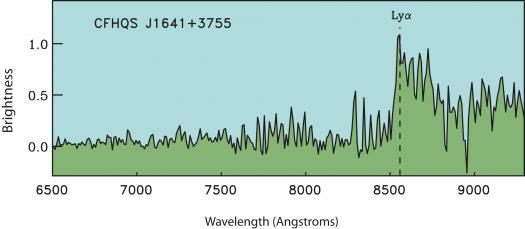Spectrum of a Distant Quasar
This chart shows the light given off by superheated material spiraling into a black hole at the heart of a galaxy 12.7 billion light-years away. This active galaxy, called a "quasar," is known as CFHQS 1641+3755. Because its light has traveled so far to us, it has lost energy, causing wavelengths to stretch. The light from neutral hydrogen gas, indicated by the label "Ly alpha" here, has stretched from a wavelength of 1216 Angstroms all the way to 8500 Angstroms. (For comparison, the human eye can only see light of wavelengths up to 6500 Angstroms.) The magnitude of this stretch, or "redshift," is what allows astronomers to calculate the quasar's distance. This quasar is one of only a handful known at such a great distance. This spectrum was taken with Marcario Low Resolution Spectrograph on the Hobby-Eberly Telescope at McDonald Observatory. Credit: Gary Hill/Tim Jones/McDonald Observatory.






